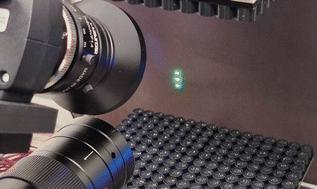Our official English website, www.x-mol.net, welcomes your
feedback! (Note: you will need to create a separate account there.)
Acoustic levitation and manipulation of columns of droplets with integrated optical detection for parallelisation of reactions
Analyst ( IF 3.6 ) Pub Date : 2024-10-18 , DOI: 10.1039/d4an01096e Ruchi Gupta, Nicholas J. Goddard
Analyst ( IF 3.6 ) Pub Date : 2024-10-18 , DOI: 10.1039/d4an01096e Ruchi Gupta, Nicholas J. Goddard

|
The most common methodology for performing multiple chemical and biological reactions in parallel is to use microtitre plates with either manual or robotic dispensing of reactants and wash solutions. We envision a paradigm shift where acoustically levitated droplets serve as wells of microtitre plates and are acoustically manipulated to perform chemical and biological reactions in a non-contact fashion. This in turn requires that lines of droplets can be levitated and manipulated simultaneously so that the same operations (merge, mix, and detect) can be performed on them in parallel. However, this has not been demonstrated until this work. Because of the nature of acoustic standing waves, a single focus has more than one trap, and can allow levitation of columns of droplets at the focal point and at half a wavelength above and below that point. Using this approach, we increased the number of acoustically levitated and merged droplets to 6 compared to 2 in the state-of-the-art. We showed that droplets in a column can be moved and merged with droplets in another column simultaneously and in a controlled manner to perform repeats and/or parallelisation of chemical and biological reactions. To demonstrate our approach experimentally, we built an acoustic levitator with top and bottom surfaces made of a 16 × 16 grid of 40 kHz phased array transducers and integrated optical detection system, studied two acoustic trap generation and movement algorithms, and performed an exemplar enzyme assay. This work has made significant steps towards acoustic levitation and manipulation of large numbers of droplets to eventually significantly reduce the use of the current state-of-the-art tools, microtitre plates and robots, for performing parallelised chemical and biological reactions.
中文翻译:

通过集成光学检测实现液滴柱的声波悬浮和操作,以实现反应的平行化
并行进行多个化学和生物反应的最常用方法是使用微量滴定板,手动或自动分配反应物和洗涤液。我们设想了一种范式转变,其中声悬浮液滴用作微量滴定板的井,并通过声学操纵以非接触方式进行化学和生物反应。这反过来又要求可以同时悬浮和操纵液滴行,以便可以并行对它们执行相同的操作(合并、混合和检测)。然而,直到这项工作才得到证明。由于声驻波的性质,单个焦点具有多个陷阱,并且可以允许液滴柱悬浮在焦点处以及该点上方和下方的半个波长处。使用这种方法,我们将声悬浮和合并液滴的数量增加到 6 个,而最先进的液滴为 2 个。我们表明,一个色谱柱中的液滴可以同时以受控方式与另一个色谱柱中的液滴移动和合并,以进行化学和生物反应的重复和/或平行化。为了通过实验展示我们的方法,我们构建了一个声悬浮器,其顶面和底面由 16 × 16 网格的 40 kHz 相控阵传感器和集成光学探测系统制成,研究了两种声阱生成和运动算法,并进行了示例酶分析。这项工作朝着声悬浮和操纵大量液滴迈出了重要一步,最终显着减少了当前最先进的工具、微量滴定板和机器人用于进行平行化学和生物反应的使用。
更新日期:2024-10-23
中文翻译:

通过集成光学检测实现液滴柱的声波悬浮和操作,以实现反应的平行化
并行进行多个化学和生物反应的最常用方法是使用微量滴定板,手动或自动分配反应物和洗涤液。我们设想了一种范式转变,其中声悬浮液滴用作微量滴定板的井,并通过声学操纵以非接触方式进行化学和生物反应。这反过来又要求可以同时悬浮和操纵液滴行,以便可以并行对它们执行相同的操作(合并、混合和检测)。然而,直到这项工作才得到证明。由于声驻波的性质,单个焦点具有多个陷阱,并且可以允许液滴柱悬浮在焦点处以及该点上方和下方的半个波长处。使用这种方法,我们将声悬浮和合并液滴的数量增加到 6 个,而最先进的液滴为 2 个。我们表明,一个色谱柱中的液滴可以同时以受控方式与另一个色谱柱中的液滴移动和合并,以进行化学和生物反应的重复和/或平行化。为了通过实验展示我们的方法,我们构建了一个声悬浮器,其顶面和底面由 16 × 16 网格的 40 kHz 相控阵传感器和集成光学探测系统制成,研究了两种声阱生成和运动算法,并进行了示例酶分析。这项工作朝着声悬浮和操纵大量液滴迈出了重要一步,最终显着减少了当前最先进的工具、微量滴定板和机器人用于进行平行化学和生物反应的使用。


















































 京公网安备 11010802027423号
京公网安备 11010802027423号